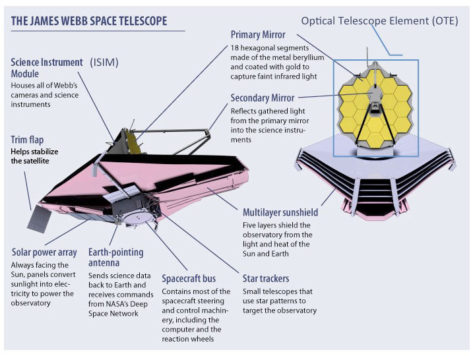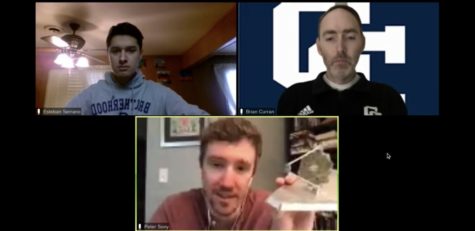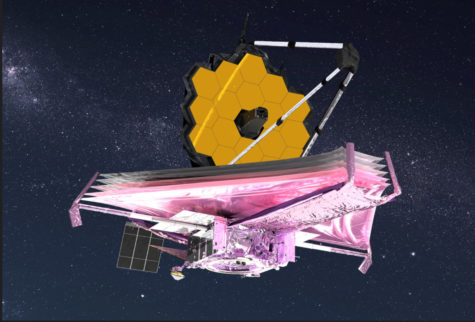EXCLUSIVE: Interview with Peter Sooy from NASA’s James Webb Team
February 1, 2022
An out-of-this-world project years in the making, finally launched this past Christmas Day. One of the most historic launches in space exploration history, and probably in the history of NASA’s existence. The James Webb Telescope launched and is now making its way beyond earth and to the outer parts of the galaxy and solar system. Scientists are hoping to discover some things such as “the first light,” which will be explained in the article, as well as get better images of planets beyond earth, all with technology surrounding infrared light- something that the Hubble Telescope wasn’t designed for.
I, along with Brian Curran, Astronomy Teacher at Central, teamed up to get some first-hand answers to bring readers some interesting, if not heavily infatuating information about the telescope. We were fortunate enough to have welcomed Peter Sooy, Communications Specialist at the Goddard Space Flight Center in Maryland, via Zoom on January 20. He talked about future plans scientists have for the telescope, some interesting facts, a wide range of statistics, and even NASA’s plans for another telescope launch later this decade.
The telescope was named after James E. Webb, the Administrator at NASA from 1961 to 1968 who was a part of the “Space Race” from that same time that helped get a man to the moon. It was (roughly) a $9.66 billion project since its early stages of designing and building in 1996.

A lot has happened since the launch on December 25- here’s a quick recap:
- December 25- The telescope launches from an Ariane 5 Rocket at Europe’s Spaceport
- January 4- The sun shield of the telescope is successfully deployed
- January 8- The telescope’s mirrors unfold successfully
It doesn’t seem like much, but the most crucial and dangerous parts of the mission have transpired. The mirrors unfolding was a huge sigh of relief for scientists, according to many reports.
This was a collaboration with 14 countries, Sooy explains. “It’s NASA, the Canadian Space Agency, and the European Space Agency. The European Space Agency has member-states in Europe with different countries… basically, most of Western Europe has a hand in ESA and they were partners on the mission.”
The interesting part is that NASA is responsible, financially, for most of the telescope’s cost. Sooy explains the rough breakdown among the countries. “More than fifty percent was NASA. Contributions from the Canadian Space Agency was one of the instruments, which is the fine guidance sensor. Then, the Europeans contributed two instruments, but the largest European contribution was the rocket.”
Sooy continues, “It launched from French Guinea in South America on an Ariane 5 Rocket, which is a French Company- It’s in South America but it’s a part of France.” Sooy also explains that there is a specific breakdown that he was unable to share in the interview, with the amount invested from each country. Telescope time and scientists from each country get to use the telescope and direct it to a specific area they would like to know more about. Say, for example, the United States actually has the most time invested in the project because of their funding. If they wanted to know more about Mars, NASA and the U.S. could actually use the telescope for their time slot and take as many pictures as they wish.
The size of the telescope is massive, compared to the Hubble Space Telescope. A rough analogy Sooy used was that Hubble is the size of a school bus, while Webb is a jumbo jet. While explaining the anatomy of the telescope, he displayed a small toy model he had and explained to us what each part’s task is. “Webb is made out of the (primary) mirror, which collects light, sends it to the secondary mirror, and then focuses to the beam into the back of the telescope where there’s four instruments.”
He continues, “This large thing here is the sun shield, that blocks the sun because it’s an infrared telescope, so we always want to keep the telescope side dark and cold, so it can sense and gather infrared heat and light. And then on the bottom side, there’s the third major part… it’s called the ‘spacecraft bus,’ this is where Webb can connect to its rockets so there’s a little ring at the bottom, and there’s a solar ring right here, that gathers the power to power the internals to the telescope instruments. And then, there’s little thrusters around the spacecraft bus as well that fire to control the orbit of Webb. Those are the three major parts,” Sooy concludes.

Sooy does stress that it is significantly bigger than Hubble, up to 6 times bigger. But he also explains that it weighs less. How is this possible?-One may be wondering. Sooy explains, “It’s half the weight of Hubble. There’s a lot of weight-saving that we used on this because of technological advances and Hubble has a solid mirror- it’s one static piece and doesn’t move. We have a segmented mirror… Eighteen segments, they all work together but they’re hollowed out in the back, so they’re lighter. While Hubble was this heavy, solid monolithic piece, Webb is segments that have been light-weighted so that they can be folded. The wings on the side fold back, so the telescope can fit in the rocket and the mirror could not be fully deployed when it was launched. So we made a segmented mirror so it could fold and deploy in space, and each segment has little actuators and motors on the back of them that move and focus them, which is something Hubble does not have… It’s kind of advancing, perfecting Hubble’s design for a newer telescope.”
While the anatomy of the entire contraption is infatuating, it isn’t the only thing getting NASA out of its comfort zone. New technologies and new ways of operating were invented in order for Webb to handle its mission in space- something that Sooy says has been a long time in the making, as these ideas for new advances date back to the late ’90s when Webb was being built. “A lot of that time was developing these technologies that we just didn’t have when we started, so there’s the technological developments and then the testing of the telescope to make sure that it would deploy well after launch.”
According to the James Webb official website governed by NASA, 8 new features were listed that have never been seen before, or are this advanced, to say the least. The eight listed that the Webb Telescope utilizes are “microshutters,” “backplane,” “lightweight cryogenic mirrors,” “wavefront sensing and control,” “infrared detectors,” “cryogenic data acquisition integrated circuit,” “sunshield coating,” and “cryocooler.” Each of these has a special role to help the telescope function, as well as keep the telescope alive.
“Hubble was designed for astronauts to go up in a space shuttle and fix it,” Sooy explains. “Webb has no design for that because it’s going to a different orbit- Hubble is about four-hundred miles up above Earth, nice and close to home, and Webb is going to orbit a million miles away from the earth, orbiting around the sun,” he states.
Speaking of Hubble, Sooy says that NASA has no plans for Hubble to stop its function and maintenance. “The goal, ideally, is that Webb and Hubble will work together complementary,” he states. “While Hubble will take images of the visible, ultraviolet spectrum of light, Webb will take similar pictures in infrared. The goal is having them work together to study our universe in a different view.”
He adds, “Webb has enough fuel for fifteen years, so it will be around for the next generation, and Hubble is thirty-one years old doing great, but it’s past its lifetime, and we don’t know how long it’s going to last.”
NASA and the other space agencies will continue to monitor it, so it doesn’t float off into space or go off the assigned track. Sooy is absolutely certain that any malfunction will likely not occur.
But with all the features, come the limitations. Due to infrared light and its position facing earth while in orbit, the telescope is not designed to see Mercury, Earth or Venus, even the sun. “It cannot look back because it would be blinded, there’s too much infrared light. So, it can look at anything from Mars out. Everything in our galaxy from Mars, out… it can look all the way out, but then it can (also) look at other galaxies and stars outside of our galaxy.”
Some may also have the curiosity of what the first photos Webb has produced, will be. The expected time according to NASA is sometime this summer, in which the photos will be released. Sooy explains the process, and what civilians can expect come the summertime. “The first images taken are a part of this package called the ‘early release observations,’ or ‘ERO’s.’ That is separate from the first year of science, so the group that is running the telescope has already decided what those ERO’s are, but it’s kind of like a very top secret. We haven’t told anybody, I don’t even know, I don’t work (directly) on the mission… I think it’s something like twenty or thirty people of the top scientists that know, and they don’t want anything released before they have the images.” He continues, “On a broader scale, there’s going to be five or six first images that come out. Things we want to look at are exoplanets, do I know which ones?- no. I’m sure we’ll look at a planet in our solar system. Do I know which one?- no. They’ll look at distant galaxies that we’ve never seen before. I’m sure there will be something about a very old galaxy that we’ve never seen- Those are kind of like our overarching science goals of seeing the first light in the universe. So, after the big bang, there was no light but then the first light that existed, that’s what it’s trying to see and we’ve never seen that before because Hubble is limited and can’t see it.”
Sooy would then expand on the goal of sighting the first light. Confusion has been lingering among some people as it is believed that Webb will attempt to “time travel,” and see the actual Big Bang play out. Sooy explains, “When the Big Bang happened, there was no light. Webb won’t be able to see the Big Bang. There’s a prior mission called ‘COBE’ (Cosmic Origins Background Explorer) that found evidence of the Big Bang based on microwaves. The scientist in charge of that, John Mather, won the Nobel Prize for that and now he is our Senior Scientist for Webb, so he’s on our mission as well.”
He continues, “While Webb won’t investigate evidence of the Big Bang, or the Big Bang exactly, it will see the first light after the Big Bang. At the Big Bang, there was a blast of microwaves that we see as evidence, but there was no light- there was no visible or infrared light like that, so the first light that started as visible, we’ll be able to see because it started as visible light like our eyes see, and its been traveling through the universe in a wave for over 13.6 or 13.7 billion years and the universe is expanding. So if you expand a wave, it gets longer, and it becomes infrared. So to see the oldest light- the first visible light, you need to be looking in the infrared for the stretched, old light. That was the primary purpose when this telescope was developed- we need to see what Hubble can’t and we want to explore older and more distant light.”
Sooy attaches the distant light skills of Webb, with what it will be able to sense when it does look at different exoplanets, and stars passing in front of atmospheres. Sooy says that one of the goals of the telescope is to potentially help figure out if life exists elsewhere than just earth.
“If you look up, every night star you see, has on average, one or two exoplanets orbiting around it. So, Webb will be able to look and hopefully will be able to see those planets when they orbit.” He says as the star transits, Webb may be able to sense the infrared light from the visible light that passes in front of the atmosphere when the star completes its transit. “Based on the light that comes to Webb, it can sense, ‘oh, this light is slightly different,’ because there’s oxygen in the atmosphere of the exoplanet or carbon monoxide or carbon dioxide. They’re all scientific constants that can determine the question or idea of the search for life or ‘aliens.’ That’s what Webb is going to do with the exoplanets.” However, while it may help answer questions, Sooy stresses it won’t be able to immediately detect any lifeforms.
“We’re not going to be able to look at an exoplanet and see an alien waving at us or an alien building or something, but we can see ‘signatures’ of life. We can (say), ‘oh wow, there’s oxygen here, that would be a great thing for life to exist on a planet that has oxygen.’ What we need to do next is build a bigger telescope to study that really cool exoplanet that really could possibly have life on it.”
Sooy, from where he works at the Goddard Space Flight Center in Maryland, can confirm there is another telescope, called Roman, to be launched sometime in this decade. “It’s going to be an infrared telescope like Webb, it’s going to have a Hubble-sized mirror, but it’s going out to L-2 like Webb, it’s going to use infrared like Webb, and it has these really fancy detectors so that it could see a hundred times wider than the view of Hubble.” He continues, “It used to be called, the ‘Wide-field Infrared Telescope.’ It’s looking wide, and it’s going to, like Webb, give us different perspectives in light and Roman is going to give us a wide-field view.” In other words, Sooy says instead of it taking multiple pictures, Roman will look with a wide shot feature that will allow a better view of multiple parts of a specific area in one photo. Its projected launch date is no later than May 2027, per NASA and Sooy.
Since the interview took place on January 20, many sources confirmed that Webb has made it to its final destination in the L2 part of the galaxy, and is ready to begin “scanning” the universe. It will give us pictures that people from Earth have never seen before of what’s way beyond our own atmosphere and galaxy.
The Pep would like to thank Peter Sooy from NASA for completing the interview, and Brian Curran for collaborating on this article.




